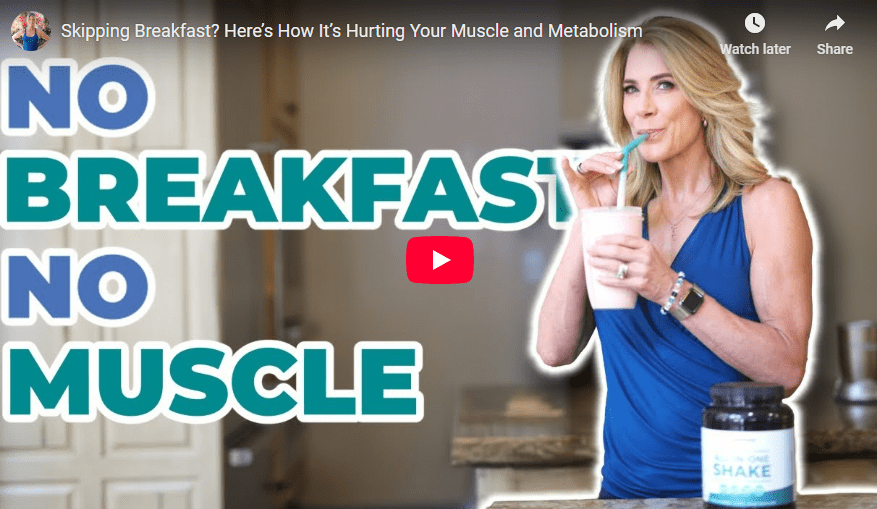Most major diet and lifestyle overhauls often fall short of expectations, leaving you frustrated and demotivated. They can even catapult you right back to where you started. The key to successful fat loss doesn’t lie in dramatic, unsustainable changes but in simple, everyday habits that are easy to integrate into your routine.
Little hinges swing big doors: by focusing on small, consistent actions, you can achieve lasting results without the stress and overwhelm of massive overhauls. These five simple, effective, science-based strategies can accelerate your fat-loss goals.
1. Track Your Progress
Tracking your progress is essential to losing fat while maintaining or building muscle. Monitoring key metrics helps you measure and adjust your diet and exercise routine, ensuring you stay on the right path. Here are three effective tools for doing so:
DEXA Body Scan
A DEXA scan is one of the most accurate methods for measuring body composition. It assesses bone density, skeletal muscle mass, body fat, and visceral adipose tissue (a type of body fat associated with a higher risk of heart disease, type 2 diabetes, and metabolic syndrome).1
Getting a DEXA scan every six months can provide a detailed snapshot of your progress, helping you see beyond the number on the scale and develop a bigger-picture perspective about your fat-loss and overall health goals. The cost is relatively affordable, ranging from $75-100, making it a worthwhile investment in your health journey.
Bioimpedance Scale
A bioimpedance or body-composition scale is a great home tool for more frequent tracking. A few decades ago, they cost thousands; today, you can find a good scale for under $100. Brands like Oxiline offer scales that measure body water, body fat, skeletal muscle, and visceral adipose tissue. Daily data collection can help you spot patterns and make necessary adjustments, ensuring you’re on track with your fat loss and muscle maintenance goals.
Tape Measure
High-tech tracking methods are great, but a simple tape measure can provide valuable insights into your progress. Measure your waist, hips, and waist-to-height ratio weekly. This helps monitor changes in body composition, particularly with muscle retention and fat loss. Remember, if you’re losing weight but not your waist, you might be losing muscle instead of fat. Your aim should be to hold on to muscle and burn fat.
2. Meditate to Manage Stress Levels
Chronic stress triggers a harmful cycle of elevated cortisol (a hormone released in response to stress) and elevated blood-sugar levels, severely hindering your fat-loss efforts.2 This nasty combination of high cortisol and blood sugar acts as a one-two punch for fat gain. Studies show that meditation can significantly lower cortisol levels, offering a powerful tool for managing chronic stress and reducing belly fat.3
Consistency is critical to great results. Just like you wouldn’t go to the gym once and expect to be fit, you shouldn’t expect instant results from meditation. Dr. Joe Dispenza’s meditations transformed my life, boosting my focus, energy, and clarity. If meditation isn’t for you, techniques like breathwork, Emotional Freedom Technique (EFT) or tapping, or any other method that helps you relax can be equally effective. Find what brings you bliss and incorporate it into your daily routine to reduce stress.
How do you know if these techniques work? One effective way to track the benefits of resistance training is by tracking your heart rate variability (HRV). HRV is a reliable indicator of your body’s stress response, providing insights into how well your body is adapting to exercise and recovering from workouts. By monitoring HRV, you can better understand the effectiveness of your plan and make adjustments to optimize your results.4
3. Optimize Physical Activity
Exercising is a hierarchy. Moving more, period, should be your first goal. Increasing your overall movement throughout the day is one of the simplest yet most effective habits for fast, lasting fat loss. Then, you can add resistance training and high-intensity interval training (HIIT) to your plan. Here’s how that should look.
General Movement
Walking is the perfect way to increase your daily movement. One study found that participants who walked 8,000 steps per day had a 51% lower risk of dying from any cause than those who walked only 4,000 steps daily. This trend was even more pronounced with higher step counts, as those who walked 12,000 steps daily had a 65% lower risk of dying than those who walked 4,000 steps.5 If you’re just starting, find your current number and gradually increase.
Find ways to move more naturally throughout your day, too. Take the stairs, park further away from the door, or even fidget—every movement counts towards your overall activity level and contributes to better health. This concept, called non-exercise activity thermogenesis (NEAT), encompasses all the calories you burn outside formal exercise.6 By boosting NEAT, you can significantly enhance your calorie expenditure and support fat loss without feeling like you’re constantly working out.
Resistance Training
Muscle is your metabolic Spanx, helping to shape and support your body while boosting your metabolism. Research shows that adults who don’t regularly perform strength training can lose 4 to 6 pounds of muscle per decade.7 Incorporating resistance training into your routine 2-4 times a week is essential for maintaining and building skeletal muscle.
Muscle acts like a sugar sponge as well, improving insulin sensitivity, boosting metabolism, and helping your body manage glucose more effectively.8 Resistance training helps burn calories and supports long-term fat loss by increasing your resting metabolic rate. In other words, your body continues to burn calories efficiently, even at rest.9
Lifting weights helps increase muscle mass, which boosts your metabolism and allows your body to burn more calories, even at rest. My free Resistance Training Cheat Sheet provides everything you need to get started, including home gym essentials, an 8-week workout plan, and a progress tracker to monitor your sets, reps, and weights with each workout.
High-Intensity Interval Training (HIIT)
Engaging in high-intensity interval training (HIIT) is another powerful strategy for fat loss. HIIT workouts involve short bursts of intense exercise followed by periods of rest or low-intensity activity. This method burns more calories quickly, boosts growth hormone levels, and helps manage stress better.10 The best part is that you can do HIIT workouts in 20-30 minutes, making them perfect for busy schedules to boost fat loss.
4. Eat Protein First
One of the most effective strategies for fat loss is eating protein first. If all you do is add optimal protein while adjusting your carb and fat intake, you’ll likely lose belly fat even if you keep your overall calorie count the same. Why? Because your body uses more energy to break down protein, so you burn more calories.11 Protein is also more filling than carbohydrates or fats, reducing the likelihood of overeating and helping you to eat fewer calories.12 Eating enough protein also supports muscle maintenance and fat loss, ensuring you retain or build muscle mass while shedding fat.13
To accurately monitor your intake, maintain a food diary and utilize tools such as the Cronometer app to track your macros. Using a food scale can also be helpful, too. Research indicates people underestimate how much food they eat – sometimes, up to 37%.14 Tracking your food intake helps you manage how much food you eat, but it can also reveal patterns that cause weight fluctuations and potential food intolerances that hinder fat loss.

5. Get Quality Sleep
Getting quality sleep is crucial for supporting insulin sensitivity and overall health. Aim for 7-9 hours of sleep each night to ensure your body functions optimally. Poor sleep can sabotage your efforts even if you eat right and exercise regularly. Research shows that even one night of crappy sleep can make you more insulin resistant, so your body can’t burn fat effectively.15
Likewise, a single night of sleep deprivation increases hunger hormones like ghrelin, making you feel hungrier (or hangrier) the next day.16 This creates a downward spiral where you’re more susceptible to poor eating choices and overeating, stalling fat loss and nose-diving your health goals. You might also find it harder to push yourself during exercise, further hindering your progress. Simply put, poor sleep becomes a vicious cycle that impacts your entire day.
Tracking is a valuable way to improve sleep, and I use an Oura Ring for this purpose. It monitors sleep duration, stages, and quality, providing insights into total sleep time, efficiency, and night awakenings. Additionally, it tracks heart rate and HRV, offering a daily readiness score based on your sleep quality, HRV, and activity. One evening, I ate too late—and my Oura Ring revealed a poor readiness score the next day, showing I missed out on deep sleep. Lesson learned!
Even the best of us struggle to fall and stay asleep every night. Melatonin, a hormone that regulates sleep-wake cycles, can help improve sleep quality and duration by signaling to your body that it’s time to rest.17
Sleep Candy™ is a uniquely formulated supplement that blends 3 mg of melatonin with 5-hydroxytryptophan (5-HTP), a precursor to melatonin. We’ve added inositol and L-theanine for extra calming effects, plus vitamin B6 to help convert 5-HTP into melatonin. This synergistic combination ensures you get your best night’s sleep every night.*
Proven Sleep Strategies for Fast, Lasting Fat Loss
To look and feel your best all day, you need 7-9 hours of quality, uninterrupted sleep every night. Great sleep doesn’t just happen; it takes preparation. I’m a busy entrepreneur with two businesses, but I never skimp on quality sleep. I’ve gathered my top tips to help you achieve your best night’s sleep ever, too. My Ultimate Sleep Cheat Sheet offers 7 proven strategies for getting the best rest possible. Optimizing your sleep supercharges your days, and this guide provides proven strategies for waking up feeling refreshed and energized.
Claim your Ultimate Sleep Cheat Sheet for free here.
References:
- UC Davis Health: DAX body composition analysis
- Mayo Clinic: Chronic stress puts your health at risk
- Turakitwanakan W, Mekseepralard C, Busarakumtragul P. Effects of mindfulness meditation on serum cortisol of medical students. J Med Assoc Thai. 2013 Jan;96 Suppl 1:S90-5. PMID: 23724462.
- Harvard Health: Heart rate variability: How it might indicate well-being
- Medical News Today: How many steps should people take per day?
- von Loeffelholz C, Birkenfeld AL. Non-Exercise Activity Thermogenesis in Human Energy Homeostasis. [Updated 2022 Nov 25]. In: Feingold KR, Anawalt B, Blackman MR, et al., editors. Endotext [Internet]. South Dartmouth (MA): MDText.com, Inc.; 2000-. Available from: https://www.ncbi.nlm.nih.gov/books/NBK279077/
- Harvard Health: Age and muscle loss
- Merz KE, Thurmond DC. Role of Skeletal Muscle in Insulin Resistance and Glucose Uptake. Compr Physiol. 2020 Jul 8;10(3):785-809. doi: 10.1002/cphy.c190029. PMID: 32940941; PMCID: PMC8074531.
- Healthline: Cardio or Weightlifting: Which Is Better for Weight Loss?
- Healthline: 7 Benefits of High Intensity Interval Training (HIIT)
- Healthline: How Protein Can Help You Lose Weight Naturally
- Noakes M. The role of protein in weight management. Asia Pac J Clin Nutr. 2008;17 Suppl 1:169-71. PMID: 18296329.
- Carbone JW, Pasiakos SM. Dietary Protein and Muscle Mass: Translating Science to Application and Health Benefit. Nutrients. 2019 May 22;11(5):1136. doi: 10.3390/nu11051136. PMID: 31121843; PMCID: PMC6566799.
- Science Direct: Food Records – an overview
- Donga E, van Dijk M, van Dijk JG, Biermasz NR, Lammers GJ, van Kralingen KW, Corssmit EP, Romijn JA. A single night of partial sleep deprivation induces insulin resistance in multiple metabolic pathways in healthy subjects. J Clin Endocrinol Metab. 2010 Jun;95(6):2963-8. doi: 10.1210/jc.2009-2430. Epub 2010 Apr 6. PMID: 20371664.
- Schmid SM, Hallschmid M, Jauch-Chara K, Born J, Schultes B. A single night of sleep deprivation increases ghrelin levels and feelings of hunger in normal-weight healthy men. J Sleep Res. 2008 Sep;17(3):331-4. doi: 10.1111/j.1365-2869.2008.00662.x. Epub 2008 Jun 28. PMID: 18564298.
- Fatemeh G, Sajjad M, Niloufar R, Neda S, Leila S, Khadijeh M. Effect of melatonin supplementation on sleep quality: a systematic review and meta-analysis of randomized controlled trials. J Neurol. 2022 Jan;269(1):205-216. doi: 10.1007/s00415-020-10381-w. Epub 2021 Jan 8. PMID: 33417003.
*These statements have not been evaluated by the Food & Drug Administration. Products mentioned are not intended to diagnose, treat, cure, or prevent any disease. The views in this blog by JJ Virgin should never be used as a substitute for professional medical advice. Please work with a healthcare practitioner concerning any medical problem or concern.
**I couldn’t make it without supportive relationships, and I bet you feel the same! That’s why my team and I offer you products and services we believe in. If you happen to purchase something I recommend here, I may receive some kind of compensation. However, I only bring you partners whose content and core values will serve you with the same commitment to excellence my team and I strive for every day. Please be in touch with any concerns.





